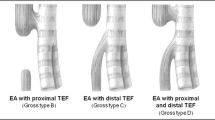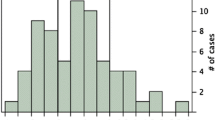Abstract
Purpose
While the diagnosis and outcomes of esophageal atresia (EA) have improved, associated anomalies, the management of late complications and growth remain major issues. We analyzed factors that affected the prognosis, late complications and growth.
Methods
We retrospectively reviewed EA patients treated at two centers from 1984 to 2016. Patient characteristics, complications (gastroesophageal reflux [GER], anastomotic stenosis, tracheomalacia, dysphagia) and growth were evaluated.
Results
Seventy-three EA patients were treated (overall survival rate:80.8%). The mean birth weight was 2514 ± 509 g in the surviving group, and 2453 ± 567 g in the fatal group excluded chromosomal abnormality (p = 0.76). Cardiac and chromosomal anomalies significantly affected mortality. Postoperative GER and anastomotic stenosis each occurred in 39% of the patients. Only GER was significantly affected by the Gross classification. The standard deviation (SD) values of the EA patients’ growth were all lower than in the normal population. The SD of body weight was significantly lower in patients with extremity anomalies.
Conclusions
Associated cardiac and chromosomal anomalies significantly affected the prognosis. GER and anastomotic stenosis were the most common late complications. The growth of the surviving cases was insufficient. These factors will help optimize the therapeutic strategies and postoperative management for EA.

Similar content being viewed by others
References
Waterston D, Carter RB, Aberdeen E (1962) Oesophageal atresia: tracheo-oesophageal fistula: a study of survival in 218 infants. Lancet 279(7234):819–822
Spitz L, Kiely EM, Morecroft JA, Drake DP (1994) Oesophageal atresia: at-risk groups for the 1990s. J Pediatr Surg 29(6):723–725
Choudhury SR, Ashcraft KW, Sharp RJ, Murphy JP, Snyder CL, Sigalet DL (1999) Survival of patients with esophageal atresia: influence of birth weight, cardiac anomaly, and late respiratory complications. J Pediatr Surg 34(1):70–74
Beasley SW, Myers NA (1992) Trends in mortality in oesophageal atresia. Pediatr Surg Int 7(2):86–89
Wang B, Tashiro J, Allan BJ, Sola JE, Parikh PP, Hogan AR et al (2014) A nationwide analysis of clinical outcomes among newborns with esophageal atresia and tracheoesophageal fistulas in the United States. J Surg Res 190(2):604–612
Deurloo JA, Ekkelkamp S, Schoorl M, Heij HA, Aronson DC (2002) Esophageal atresia: historical evolution of management and results in 371 patients. Ann Thorac Surg 73(1):267–272
Okamoto T, Takamizawa S, Arai H, Bitoh Y, Nakao M, Yokoi A et al (2009) Esophageal atresia: prognostic classification revisited. Surgery 145(6):675–681
Cassina M (2016) Prevalence, characteristics, and survival of children with esophageal atresia: a 32-year population-based study including 1,417,724 consecutive newborns Survival for Children with Esophageal Atresia. Birth Defects Res A 106(7):542–548
Beasley S, Allen M, Myers N (1997) The effects of Down syndrome and other chromosomal abnormalities on survival and management in oesophageal atresia. Pediatr Surg Int 12(8):550–551
Shawyer AC, Pemberton J, Kanters D, Alnaqi AA, Flageole H (2015) Quality of reporting of the literature on gastrointestinal reflux after repair of esophageal atresia- tracheoesophageal fistula. J Pediatr Surg 50(7):1099–1103
Yanchar NL, Gordon R, Cooper M, Dunlap H, Soucy P (2001) Significance of the clinical course and early upper gastrointestinal studies in predicting complications associated with repair of esophageal atresia. J Pediatr Surg 36(5):815–822
Montedonico S, Diez-Pardo JA, Possogel AK, Tovar JA (1999) Effects of esophageal shortening on the gastroesophageal barrier: an experimental study on the causes of reflux in esophageal atresia. J Pediatr Surg 34(2):300–303
Kawahara H, Kubota A, Hasegawa T, Okuyama H, Ueno T, Watanabe T et al (2007) Lack of distal esophageal contractions is a key determinant of gastroesophageal reflux disease after repair of esophageal atresia. J Pediatr Surg 42(12):2017–2021
Baird R, Laberge J-M, Lévesque D (2013) Anastomotic stricture after esophageal atresia repair: a critical review of recent literature. Eur J Pediatr Surg 23(03):204–213
Vukadin M, Savic D, Malikovic A, Jovanovic D, Milickovic M, Bosnic S et al (2015) Analysis of prognostic factors and mortality in children with esophageal atresia. Indian J Pediatr 82(7):586–590
Spitz L, Kiely E, Brereton RJ (1987) Esophageal atresia: Five year experience with 148 cases. J Pediatr Surg 22(2):103–108
Slany E, Holzki J, Holschneider AM, Gharib M, Hugel W, Mennicken U (1990) [Tracheal instability in tracheo-esophageal abnormalities]. Z Kinderch 45(2):78–85
Dave S, Currie BG (2006) The role of aortopexy in severe tracheomalacia. J Pediatr Surg 41(3):533–537
Engum SA, Grosfeld JL, West KW, Rescorla FJ, Scherer LR 3rd (1995) Analysis of morbidity and mortality in 227 cases of esophageal atresia and/or tracheoesophageal fistula over two decades. Arch Surg 130(5):502–508
Krishnan U, Mousa H, Dall’Oglio L, Homaira N, Rosen R, Faure C et al (2016) ESPGHAN-NASPGHAN guidelines for the evaluation and treatment of gastrointestinal and nutritional complications in children with esophageal atresia–tracheoesophageal fistula. J Pediatr Gastr Nutr 63(5):550–570
Little DC, Rescorla FJ, Grosfeld JL, West KW, Scherer LR, Engum SA (2003) Long-term analysis of children with esophageal atresia and tracheoesophageal fistula. J Pediatr Surg 38(6):852–856
Gischler SJ, van der Cammen-van Zijp MHM, Mazer P, Madern GC, Bax NMA, de Jongste JC et al (2009) A prospective comparative evaluation of persistent respiratory morbidity in esophageal atresia and congenital diaphragmatic hernia survivors. J Pediatr Surg 44(9):1683–1690
Presse N, Taillefer J, Maynard S, Bouin M (2016) Insufficient body weight of adults born with esophageal atresia. J Pediatr Gastr Nutr 62(3):469–473
Acknowledgements
We thank Mr. Brian Quinn for his comments and help with the manuscript. This study was supported by a Grant-in-Aid for Scientific Research from the Japan Society for the Promotion of Science (JSPS, Nos. 26670765, 16K10466, 16K10094, 16K10095, 16K10434, 16H07090, 17K10555, 17K11514, 17K10183, 17K11515), a research grant from the President’s Discretionary Expenses of our university, and a research grant from The UBE Foundation.
Author information
Authors and Affiliations
Corresponding author
Ethics declarations
Conflict of interest
The authors declare no conflicts of interest in association with the present study.
Rights and permissions
About this article
Cite this article
Masuya, R., Kaji, T., Mukai, M. et al. Predictive factors affecting the prognosis and late complications of 73 consecutive cases of esophageal atresia at 2 centers. Pediatr Surg Int 34, 1027–1033 (2018). https://doi.org/10.1007/s00383-018-4326-1
Accepted:
Published:
Issue Date:
DOI: https://doi.org/10.1007/s00383-018-4326-1




